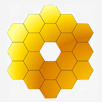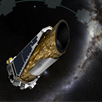MAST is now hosting simulated data from the James Webb Space Telescope's NIRCam and NIRISS science instruments, in multiple configurations. Created by instrument teams at STScI, these data are available for download by potential investigators to gain some working familiarity with JWST instrument performance and data. These data simulations will allow for software testing and debugging, and will illustrate differences between the multiple observing modes across James Webb's array of instruments, prior to the Cycle 1 Call for Proposals. For all currently-available JWST simulated data files, go here:
All science images and ancillary data are available for individual download, along with source list files and ancillary data where provided. In addition to the content files, README files are provided from each simulation team that describe the simulations and file contents in detail. Simulated data sets for both the MIRI and NIRSpec instruments are also available through ESA and are linked to the same page. More details on JWST instruments, modes, and specifications can be found on the JWST User Documentation page.
| Instrument: |
Available Modes: |
| MIRI (@ESA) |
Imaging |
| Low-Resolution Spectroscopy (LRS) |
| Med-Resolution Spectroscopy (MRS) |
| NIRCam |
Imaging |
| NIRISS |
Aperture-Masking Interferometry (AMI) |
| Imaging |
| Wide-Field Slitless Spectroscopy (WFSS) |
| Single-Object Slitless Spectroscopy (SOSS) |
| NIRSpec (@ESA) |
Multi-Object Spectroscopy (MOS) |
| Integral Field Unit Spectroscopy (IFU) |
MAST is now also hosting the sky background database for JWST. These are the same background intensities that are used by the JWST Exposure Time Calculator, and will be used by the jwst_backgrounds toolset to be released soon. The individual background files are available at archive.stsci.edu/missions/jwst/simulations/straylight/sl_cache/ under numbered subdirectories (e.g. /0000/sl_pix_000000.bin). Bundled .tgz files containing all .bin files are also available below:
Many thanks to all the instrument scientists who contributed to these data sets and for allowing the general public to get their first taste of the JWST data to come! Questions about accessing the simulated data can be directed to archive@stsci.edu.
Many astronomical studies need an accurate understanding of a detector’s point-spread function (PSF). For example, astrometry and photometry of point sources, faint or bright, cannot be done with high precision without PSF-fitting. In a similar vein, studies of weak lensing and other objects that are close to the resolution limit can be very dependent on the fidelity of the PSF model.
Unfortunately, it is hard to construct good PSF models. The WFC3/UVIS detectors are mildly undersampled, which means that an accurate PSF can only be constructed from a dithered set of data, and one must take exquisite care to accurately represent the sub-sampled nature of the PSF. A representative sample of WFC3 PSFs for the UVIS and IR detectors are provided on the WFC3/PSF webpage. However, these PSFs correspond to only a specific focus value. It is well known that the PSF changes over time due to secular and breathing-related changes in instrument focus.
To facilitate users in building WFC3 PSFs appropriate for their observations, we are making a full dataset of WFC3 observed PSFs available. The database contains more than 20 million PSFs, and includes all WFC3/UVIS observations taken during 2009 to 2015. The database also includes model focus values taken from the webpages http://www.stsci.edu/hst/observatory/focus/FocusModel and http://focustool.stsci.edu/cgi-bin/control.py, which take the breathing of the HST within the orbit into account.
The WFC3 PSF database can be used to generate PSFs appropriate to individual observations (filter, detector, focus value, etc.). This collection may also be used to build delta-PSFs and combined with the library PSFs. These resulting PSFs are expected to be more representative of specific observations, and will be more useful in obtaining accurate photometry/astrometry. This searchable database of WFC3 UVIS observed PSFs is available through the MAST Portal by selecting the “WFC3 UVIS PSF” collection.
Questions about how to access or use the WFC3 PSF database may be directed to archive@stsci.edu.
There have been several updates regarding K2 and Kepler data holdings at MAST in the past month. Detrended K2 light curves from Vanderburg et al. (K2SFF) from Campaign 11 are now available at MAST. See the K2SFF HLSP page for data access information. In addition, pipeline-processed K2 light curves for Campaign 12 are available on the MAST K2 homepage, which includes TRAPPIST-1, WASP-28, HD 218566, and the minor planet Chiron. Data release notes are also available for both campaigns, and users are encouraged to consult them prior to accessing the data (C11 Release Notes, C12 Release Notes).
As part of Kepler closeout, the team has released the pipeline code on Github as open source. The software release will enhance the long-term legacy of the Kepler data by allowing researchers to read any line of the source code. This is critical to not only understand the processing at a deep level, but also for future researchers who want to perform their own data reduction using new techniques. The Github page is also linked on the MAST Kepler homepage under “Documentation -> Data Processing Pipeline” on the left-side menu bar.
Any questions regarding access to or content of this source code can be directed to archive@stsci.edu.



